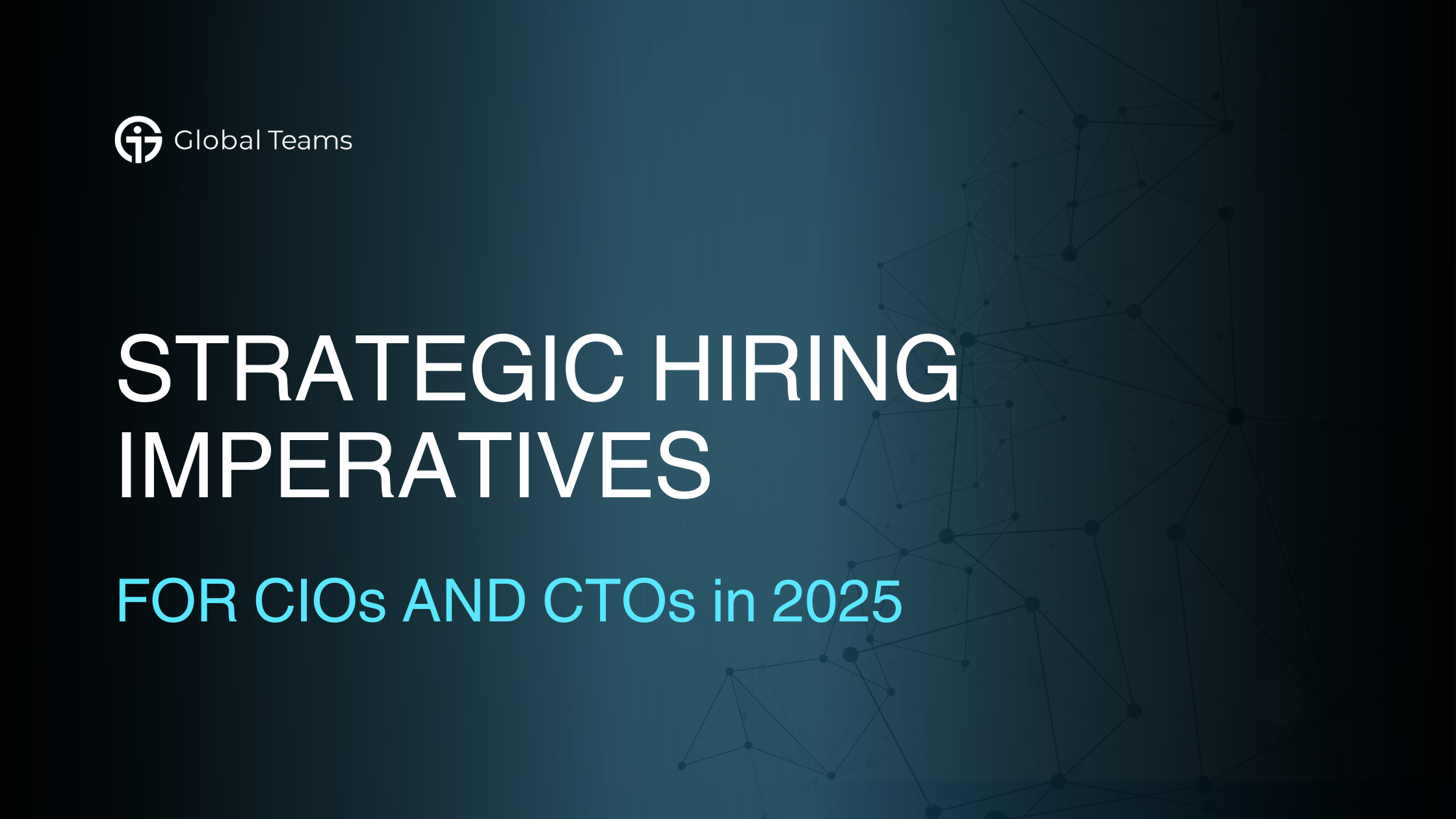Strategic Hiring Imperatives for CIOs and CTOs in 2025

With the acceleration of AI, shifting dynamics of remote work, and evolving compensation structures, technology leaders face unprecedented challenges in building and maintaining high-performing teams. As talent ecosystems become increasingly complex, organizations lacking specialized expertise often find themselves at a significant disadvantage. This article provides actionable intelligence to help CIOs and CTOs navigate technical hiring.
Evolving from Credentials to Capabilities: The Skill-Based Hiring Revolution
Research indicates that conventional hiring practices are often poor predictors of on-the-job performance. Instead of prioritizing degrees, resumes, and pedigree, skills-based hiring emphasizes validated capabilities over formal qualifications, leading to:
- 41% reduction in mis-hires
- 27% faster time-to-productivity
- 34% increase in workforce diversity
What CIOs and CTOs Should Do
Shifting to a skills-based hiring model evaluates candidates based on technical competencies, soft skills, and the ability to perform specific tasks relevant to the role.
- Replace rigid experience requirements (e.g., “5+ years of Java”) with capability benchmarks that reflect actual role needs.
- Create role-specific technical assessments using real-world scenarios to evaluate coding, systems thinking, or problem-solving ability.
- Utilize blind assessment tools to reduce unconscious bias and uncover underrepresented talent.
- Evaluate cultural and team alignment separately, ensuring candidates not only perform but also thrive within your environment.
This approach is especially relevant in technology industries where job requirements constantly change and new tools and platforms emerge regularly. By focusing on capabilities and employee potential, companies can reduce time-to-hire, improve retention, and future-proof their workforce.
Organizations adopting this model often rely on skills assessments, project-based interviews, and portfolio reviews to gauge suitability, moving beyond the resume to get a clearer picture of each candidate’s value.
Companies like IBM and Google have famously embraced this model, and the World Economic Forum predicts over 50% of employees will require reskilling by 2025, making skills-based hiring essential for long-term adaptability.
Expanded Talent Access: Moving Beyond Geographic Boundaries
The pandemic has normalized remote work, but only a fraction of companies have developed the necessary infrastructure to hire and integrate distributed teams effectively. Those that do enjoy faster hiring cycles and enhanced innovation capacity.
Companies constrained to local hiring experience:
- 3.2x longer vacancy periods
- Higher compensation overhead
- Limited access to specialized skills
Meanwhile, teams with distributed hiring strategies benefit from:
- 32% productivity increase with ≥4 hours of time zone overlap
- 47% higher collaboration effectiveness with cultural onboarding protocols
- Improved retention through flexible and inclusive work design
The shift to distributed hiring enables access to highly capable individuals in emerging markets, remote regions, or non-traditional career paths. It also empowers businesses to build more agile and resilient teams by sourcing niche skill sets that may not be readily available in local labor markets.
Reconsider Hiring Practices
Unlocking global talent begins with reconsidering conventional hiring practices that may have overlooked capable individuals. Here are a few actionable policies that smooth team integration.
- Implement follow-the-sun models where teams are distributed but maintain core overlapping hours for collaboration.
- Design cultural onboarding toolkits that foster belonging, inclusion, and engagement from Day 1.
- Adopt a hybrid communication strategy: utilize daily asynchronous updates (via tools like Loom, Notion, or Slack) in combination with twice-weekly live meetings to sync and strategize.
Because the internal buildout of these capabilities can be complex, many technology leaders are forming strategic outstaffing partnerships that provide turnkey access to distributed, fully integrated engineering teams.
Incorporating tools like virtual assessments, asynchronous interviews, and project-based evaluations ensures that talent is evaluated on merit, not proximity. Ultimately, this approach supports global scalability, strengthens workforce diversity, and drives innovation by bringing together the best minds—regardless of where they are.
Enhanced Recruitment: Precision at Scale
AI has moved from hype to application in recruitment. When integrated thoughtfully, it delivers significant improvements in hiring accuracy and velocity.
Key benefits of AI-augmented recruiting include:
- 23% improvement in interview-to-offer conversion rates via better candidate-role matching
- 41% reduction in screening time through automated technical evaluations
- 3.2x increase in outreach response rates via personalized communication at scale
Use the Right Hiring Tools
To maximize AI’s effectiveness:
- Invest in platforms with robust matching algorithms that integrate with your ATS and score candidates based on role fit.
- Leverage AI-powered technical assessments but include human validation to avoid false negatives or over-reliance on automation.
- Use machine learning-driven personalization engines to tailor outreach messages, especially critical when engaging passive candidates.
It is essential to maintain transparency and compliance, as outlined in guidelines such as those from the EEOC, when deploying AI tools. As technology matures, the advantage will shift to those who combine human empathy with machine intelligence.
From Reactive to Strategic Hiring
Facing challenges in hiring due to high competition and costs, GameDay partnered with Global Teams. Through an outstaffing model, Global Teams provided a qualified CTO who effectively led the company’s IT department and technical operations, facilitating the successful development of the mobile game. This approach highlighted the benefits of outstaffing in accessing top-tier talent efficiently.
Hiring in 2025 is not about playing catch-up; it’s about staying ahead. It’s about building a proactive, resilient talent engine. CIOs and CTOs who adopt these imperatives will be best positioned to scale innovation, increase operational flexibility, and establish a lasting technical advantage.
When you partner with an experienced outstaffing provider, you will reduce hiring costs and fill your staff rosters quickly. Contact Global Teams to learn more.